Originally shared on herculessilver.com
Hercules Silver Corp. (“Hercules Silver” or the “Company”) (TSX-V: BIG) (OTCQB: BADEF) (FWB: 8Q7) is pleased to showcase the results of its 2023 deep-seeking 3D induced polarization (“IP”), direct current resistivity and drone magnetic geophysics over the area to be drill tested in 2024, revealing multiple prospective targets, coincident with the direction of increasing copper porphyry grades seen in the initial 2023 deep discovery holes drilled at its Hercules Property in western Idaho (“Hercules” or the “Property”).
Highlights
- Conductivity anomaly below historical mining at the Belmont Zone.
- High grade cores of porphyry copper systems can often have highly conductive copper sulfide vein networks, making Belmont a potential target for a high grade core at depth.
- High grade chalcocite, typical of the porphyry enrichment blanket, was recently found on historical waste dumps at Belmont, indicating 1870’s mine tunnels may have reached the top of the porphyry system.
- Kilometers of prospective chargeability from Belmont to Grade Creek.
- The high-grade core of a porphyry will typically have ~1-3% copper sulfide with moderate chargeability values, surrounded by a highly chargeable halo of up to 10% disseminated pyrite.
- Moderate chargeability anomaly near surface at the Big Cut Skarn provides an additional satellite drill target.
- 3D magnetic inversion reveals magnetic highs potentially associated with a potassic core.
- Soil sampling, mapping, and prospecting planned to cover extensions of newly identified geophysical targets.
- Preparations underway for commencement of the 2024 drill program. The Company plans to provide updates once mobilization of drill rigs begins.
Chris Paul, CEO and Director of the Company, noted: “We’re pleased to showcase the much-anticipated results of our 2023 deep-seeking geophysics in advance of the upcoming drill campaign. We now recognize that the initial 2022 IP survey covered just a small portion of a much larger system which shows the potential for multiple porphyry centers. We see patterns in the magnetics, conductivity, and chargeability that are consistent with typical zoning of a large porphyry system, including a magnetic and conductive core surrounded by a strong chargeability halo. In 2023, we found the copper grades to be increasing towards what we now see as the most prospective targets on the Property. We’re excited to test these new high priority targets for the first time, as we expand our search for the potential high-grade core.”
Chargeability
Hercules entered the early stages of a new porphyry discovery last year with a series of initial deep drill holes testing an unexpected and poorly depth constrained 2022 chargeability anomaly. Five deep drill holes encountered strong phyllic alteration, which is typical of the margins of a porphyry system, over approximately 450m x 500m.
Dias Geophysical Inc. was brought back in 2023 to carry out a property-wide deep-seeking IP survey designed to explore the new Leviathan Porphyry at depth. The new survey expands on the initial chargeability anomaly first tested last year and reveals trends that are comparable with known porphyry copper systems.
Figure 1 (see below) provides a depth slice of the chargeability at 800 meters elevation to illustrate the distribution of disseminated sulfide mineralization in the lower plate. The core of a porphyry system often contains ~1-3% disseminated copper sulfides and is expected to produce a moderate chargeability anomaly consistent with what is outlined by the 2024 drill target corridor in Figure 1. Strong chargeability values to the east and west of the target corridor are interpreted to represent phyllic margins of the system with up to 10% disseminated pyrite. Figure 2 (see below) provides an east facing cross-section of chargeability with 2023 deep drill holes shown for reference.
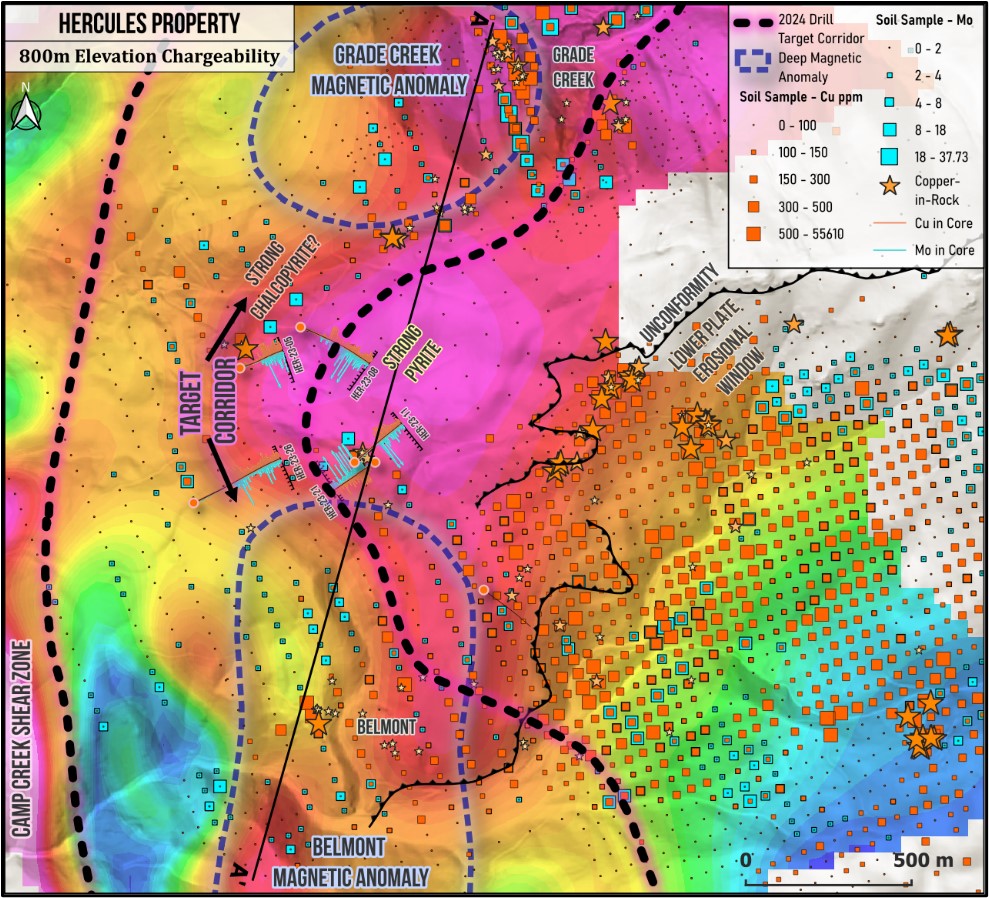
Figure 1: Chargeability depth slice (800m elevation), surface trace of deep magnetic anomalies, and copper and molybdenum geochemistry. Black dashed lines outline target corridor of optimal chargeability, high conductivity and deep-seated magnetic anomalies, open to the north.
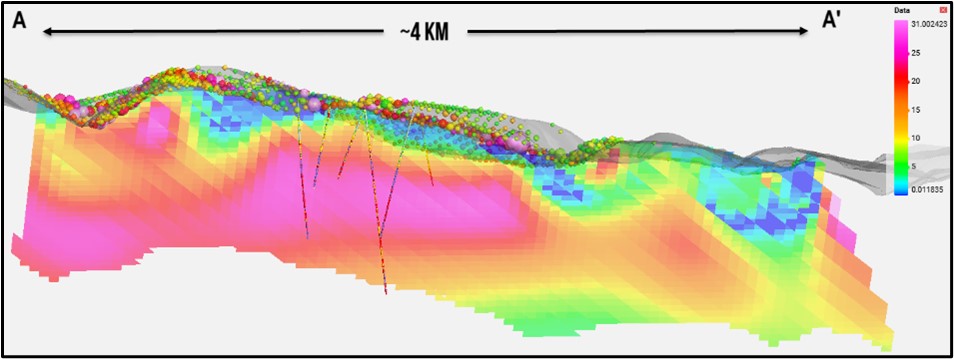
Figure 2: Chargeability section looking east (A-A’ in Figure 1)
Conductivity/Resistivity
Chargeability is influenced by non-connected disseminated sulfide mineralization. Conductivity is influenced by interconnected sulfide mineralization. At the core of some porphyry copper systems, sulfides can form a network of interconnected stockwork veinlets with high conductivity/low resistivity. Figure 3 (see below) provides a depth slice of conductivity (inverse of resistivity) at 900 meters elevation, demonstrating a compelling <30 ohm-m drill target at the Belmont that trends north through the 2024 target corridor and is bound to the west by a strongly pyritic shear zone.
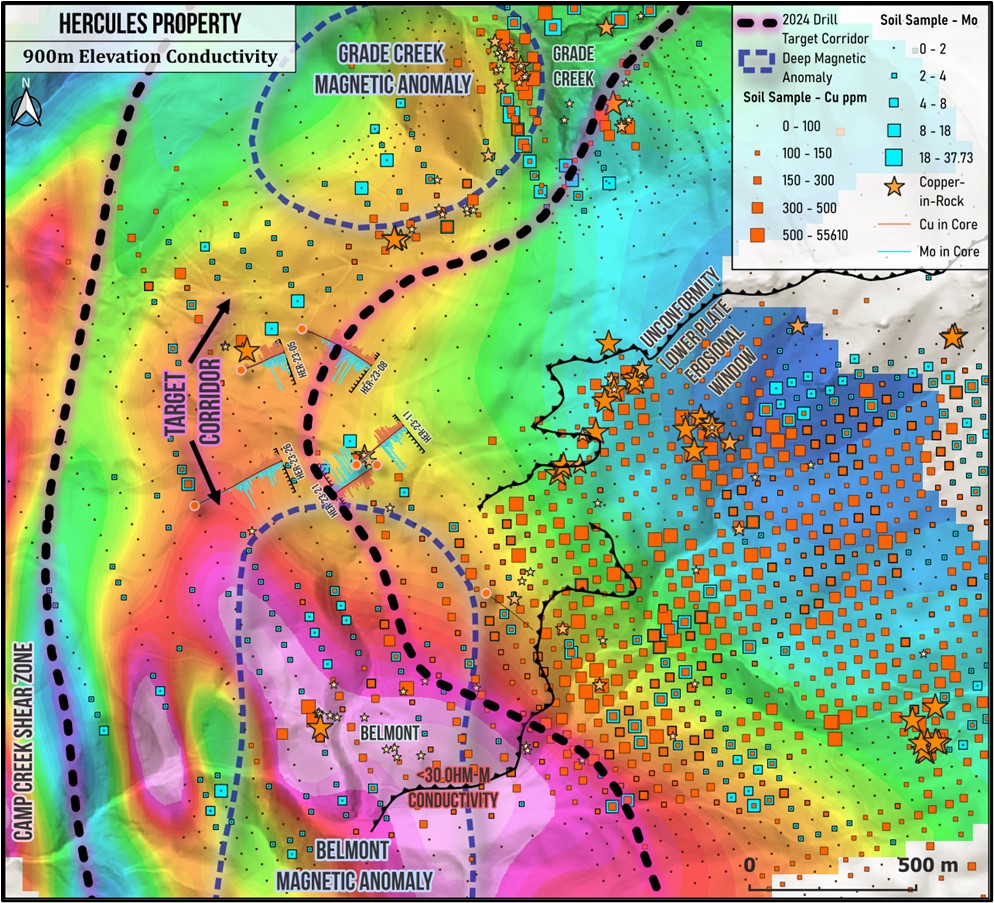
Figure 3: Conductivity depth slice (900m elevation). Black dashed lines outline target corridor of moderate chargeability, high conductivity and deep-seated magnetic anomalies. Note strong conductivity (<30 ohm-m core) associated with magnetic anomaly at the Belmont Zone.
Belmont Zone Chalcocite
Prospecting of historical underground mine dumps at the Belmont uncovered a certain distinct rock unit with strong chalcocite mineralization, a copper mineral typical of the porphyry enrichment blanket. Very little historical record is available of the mining activity that took place at Belmont during the 1870’s-1880’s, which only reported high-grade silver-lead-zinc mined from the Hercules Rhyolite. However, certain rocks found on the mine dumps at Belmont host an enriched style of porphyry copper mineralization which is not hosted in Hercules Rhyolite. In fact, the rock resembles a sheared conglomerate unit which usually occurs just above the porphyry enrichment zone.
The chalcocite mineralized rocks, which are shown below in Photo 1, indicate that historical mining may have tunneled to the top of the porphyry, at which point ground conditions likely hindered further progress. If that is the case, the semi-massive chalcocite mineralization represents a potential source of the conductivity anomaly below Belmont.
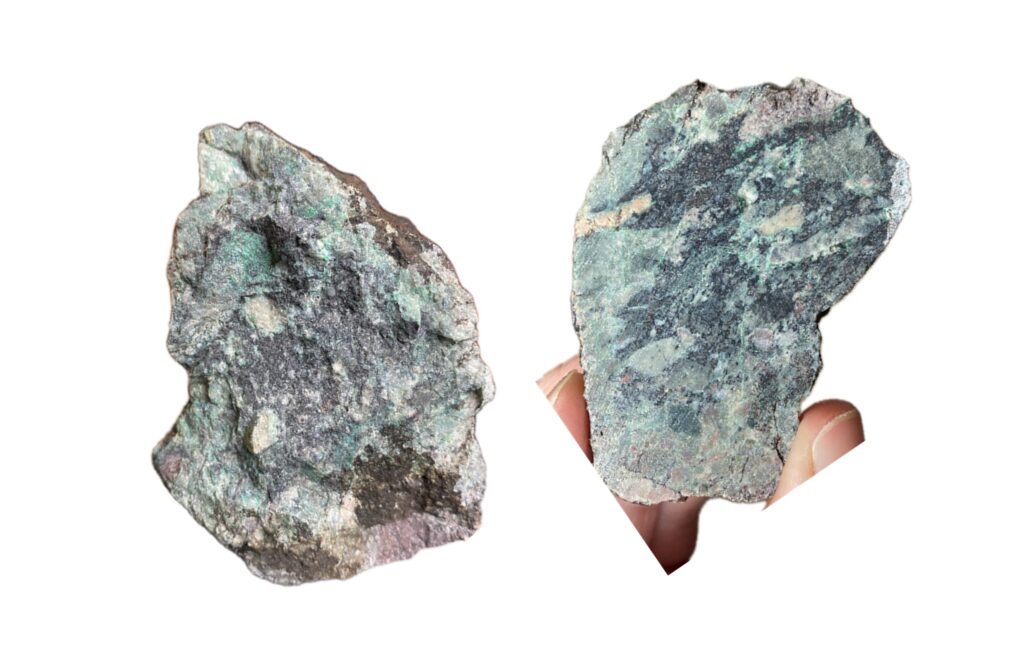
3D Drone Magnetic Inversion
A 2023 drone magnetic survey was modelled in 3D to investigate potential magnetite enrichment at depth. Magnetite is typically associated with potassic alteration at the center of porphyry systems. The 3D inversion modelled two magnetic high anomalies at depth within the target corridor. One occurs below the Belmont conductivity anomaly described above. A second cylindrical anomaly is associated with a copper-molybdenum soil anomaly at the Hercules Ridge and Grade Creek Zones. Figure 4 (see below) provides an east-facing 3D view of the magnetic anomalies (in blue) relative to copper-in-soil. Figures 1 and 3 show the surface trace of the magnetic anomalies in plan view.
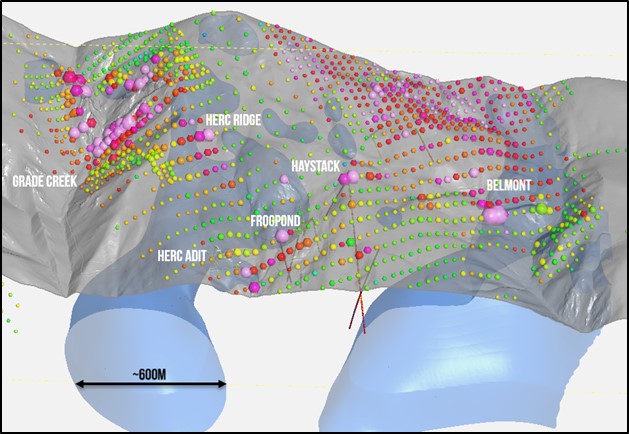
Figure 4: View looking down and to the east at 3D magnetic anomalies (blue isosurfaces) with copper in soils shown as graduated points on surface. Note the 3D inversion connected the deep anomaly below Belmont with a flat lying blanket of highly magnetic post-mineral basalts that cap the ridge south of Camp Creek, which is likely inaccurate.
3D Geophysical Compilation
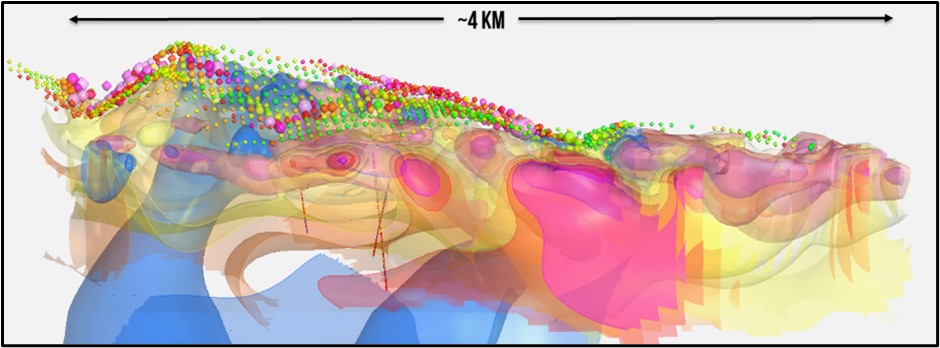
Figure 5: 3D geophysical compilation looking east. Chargeability and conductivity isosurfaces are shown in warm colours and 3D magnetic anomalies in blue. Note the mushroom shaped chargeability/conductivity remains open below the survey limit at 900 meters depth.
Big Cut Copper-Gold Skarn Target
Historical trenching at the Big Cut skarn reportedly uncovered copper sulfide mineralization associated with quartz porphyry sills and dykes intruding a limestone. Historical exploration in 1973 and 1976 reported trenches grading up to 1.78% copper across 90 feet (~27 meters) and 1.30% copper across 57 feet (~17 meters)[1],[2]. Historically, silver was only selectively assayed, and gold was not assayed. However, select grab samples[3] taken by the Company in 2022 indicate the presence of both gold and silver (See below, Figure 6). Historical trench intercepts at the Big Cut include[4]:
Table 1 – Big Cut Select Historical Trenching Results
| Length (ft.) | Length (m) | Cu (%) | Ag (oz/t) |
| 90 | 27 | 1.78 | NR |
| 57 | 17 | 1.30 | NR |
| 40 | 12.2 | 1.58 | NR |
| 180 | 54.9 | 0.94 | NR |
| 40 | 12.2 | 0.91 | NR |
| 60 | 18.3 | 0.91 | NR |
| 115 | 35.1 | 0.93 | NR |
| 7 | 2.1 | 2.68 | 0.98 |
| 60 | 18.3 | 0.83 | NR |
| 70 | 21.3 | 0.63 | NR |
NR = Not Reported
The Company plans on testing a shallow (1,250m elevation) chargeability anomaly at Big Cut during the 2024 drill program. The anomaly is situated at the edge of the IP survey and may plunge to the south at depth. Tilting of porphyry’s is common within this tectonic environment and it is not yet understood what, if any, degree, or direction of tilting may have occurred at Leviathan.
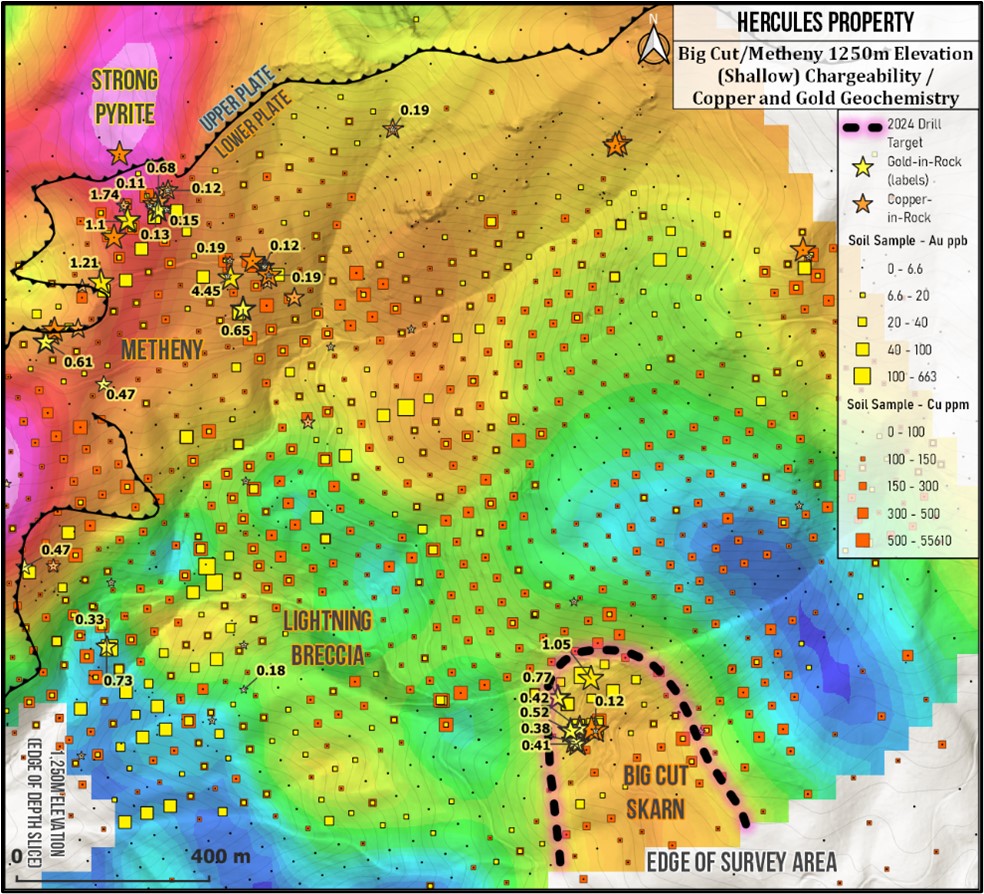
Figure 6: Shallow chargeability depth slice (1,250m elevation) at the Big Cut/Lightning/Metheny zones with copper and gold geochemistry3. A moderate chargeability anomaly at the Big Cut sits on the southern edge of the 2023 survey, which may plunge south at depth.
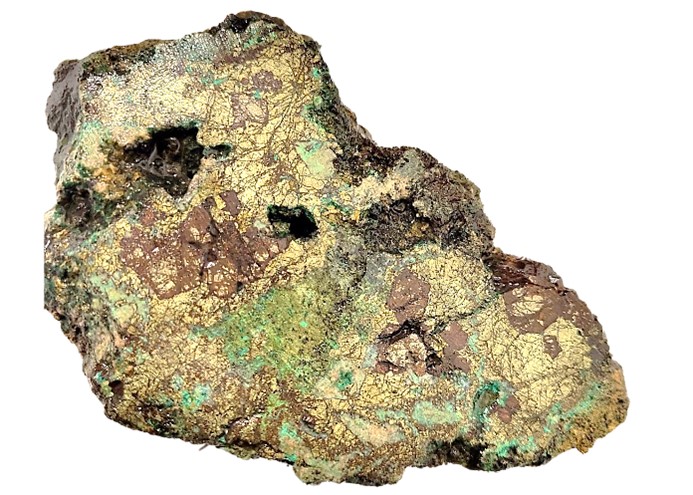
Examples of Geophysical Responses over Known Porphyry Copper Systems
The following section presents geophysical case studies from known porphyry copper systems, sourced from Hoschke (2008)[5], for educational purposes only. Geophysics are an important tool in porphyry exploration, however they do not necessarily indicate economic mineralization and require drilling to determine the cause of their anomalies.
This section contains information on properties which Hercules Silver has no right to explore or mine and readers are cautioned that mineral deposits on the following properties are not indicative of mineral deposits on the Company’s properties.
Figure 7 provides an idealized cross-section of porphyry alteration and sulfide mineral zonation from Lowell and Guilbert’s 1970 model[6], and a depth slice of the IP chargeability response from the Poison Mountain copper porphyry, British Columbia, Canada.
Figure 8 shows an example of IP chargeability at the large Batu Hijau porphyry copper system in Indonesia relative to chalcopyrite and pyrite concentrations.
Figure 9 shows the alteration, magnetics, resistivity, and chargeability response at the Elang porphyry copper system in Indonesia.
Figure 10 shows the alteration, RTP magnetics, potassium, geology, resistivity, and topography at the Bajo de la Alumbrera porphyry copper system in Argentina.

Figure 7: (a) Lowell and Guilbert’s 1970 model showing idealized porphyry alteration and mineral zonation. (b) IP chargeability response for the Poison Mountain copper porphyry, BC, Canada[7].

Figure 8: (a) Chalcopyrite and (b) pyrite concentrations on an east-west section through Batu Hijau porphyry copper deposit in Indonesia[8]. (c) Location of the section on the gradient array chargeability. (d) Chargeability section from a 3D inversion model of the gradient array and dipole-dipole IP with the drillhole sulfur results.
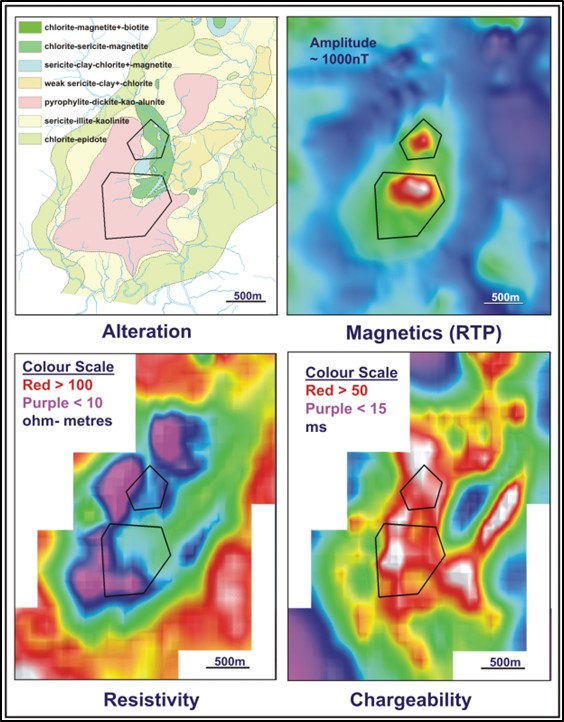
Figure 9: Elang porphyry copper system showing a plan of alteration, RTP magnetics, 200m depth slice of resistivity, and 200m depth slice of chargeability. The polygons in black show the surface projection of the interpreted magnetic bodies.
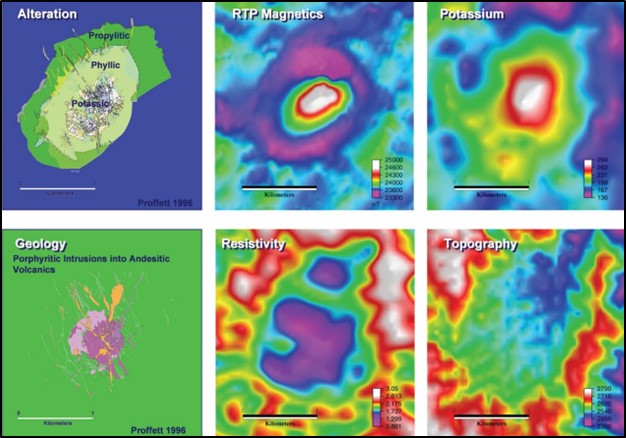
Figure 10: Alumbrera porphyry copper system with alteration, RTP magnetics, potassium, geology, resistivity and topography.
Qualified Person
The scientific and technical information in this news release has been reviewed and approved for disclosure by Christopher Longton BS, CPG, Hercules’ Vice President, Exploration. Mr. Longton is a “Qualified Person” for Hercules Silver within the meaning of National Instrument 43-101 – Standards of Disclosure for Mineral Projects.
Corporate Update
The Company also announces that it has granted an aggregate of 1,916,000 restricted share units (“RSUs“) in accordance with the terms of its omnibus incentive plan, to certain senor officers and directors of the Company. 1,500,000 of the RSUs were awarded to one of the officers of the Company pursuant to the terms of a January 2022 consulting agreement with the Company. The RSUs will vest in four equal tranches over a period of twenty-four months.
About Hercules Silver Corp.
Hercules Silver Corp. is a junior mining company focused on the exploration and development of the 100% owned Hercules Silver Project, northwest of Cambridge, Idaho.
The Hercules project is a disseminated silver-lead-zinc system with 28,000 meters of historical drilling across 3.5 kilometers of strike. The discovery of the new Leviathan porphyry copper system adds significant upside to the Property. The company is well positioned for growth through the drill bit, having completed extensive surface exploration consisting of soil and rock sampling, geological mapping, IP geophysics.
The Company’s management team brings significant exploration experience through the discovery and development of numerous precious metals projects worldwide.
